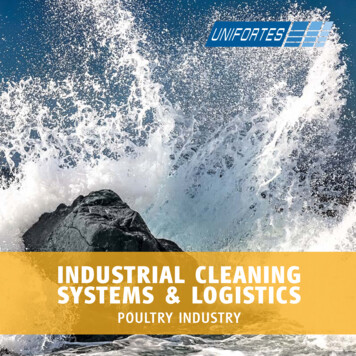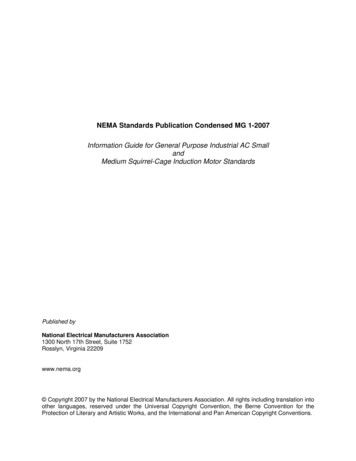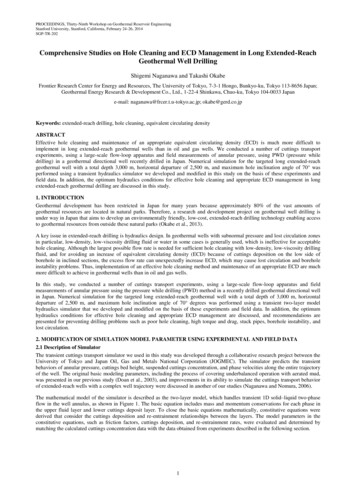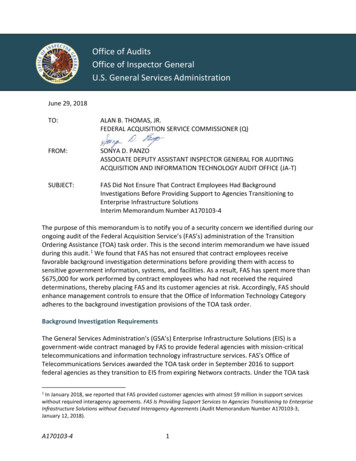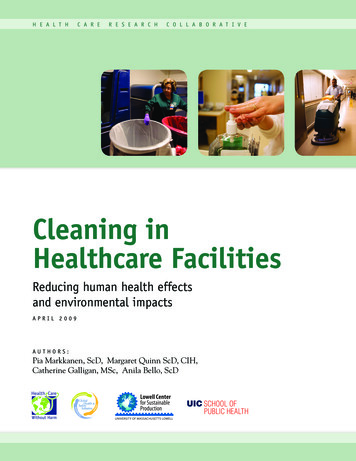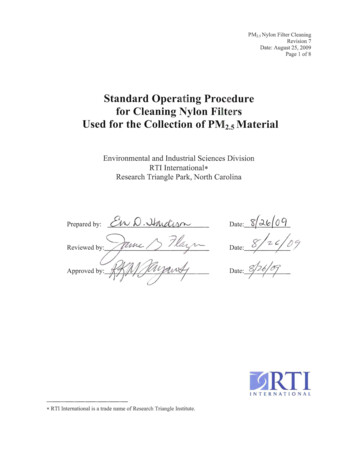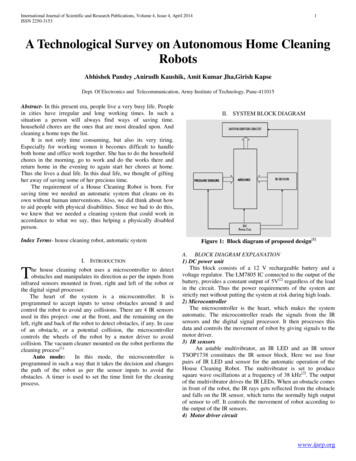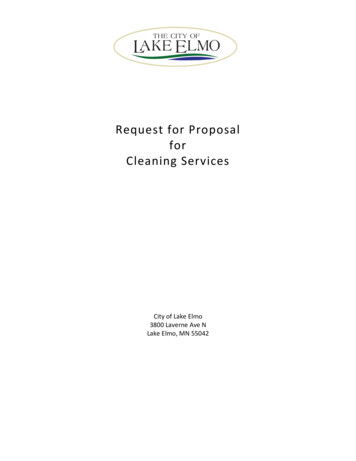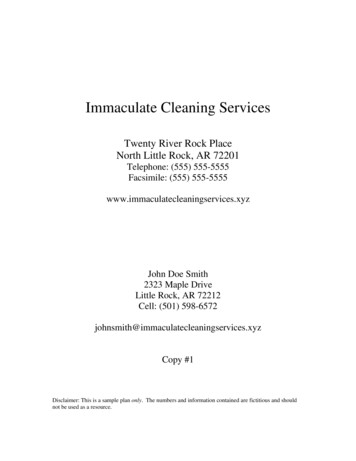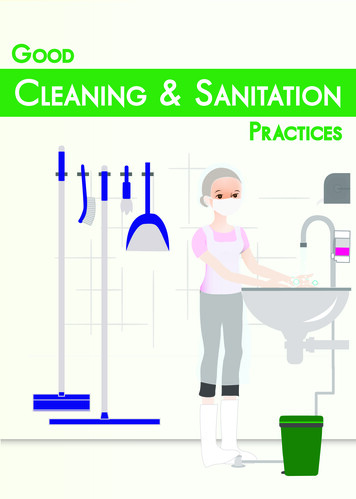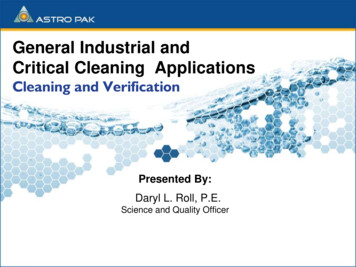
Transcription
General Industrial andCritical Cleaning ApplicationsCleaning and VerificationPresented By:Daryl L. Roll, P.E.Science and Quality Officer
Systems Requiring Chemical Cleaning Oxygen (LOX,GOX) Ammonia Gas Diesel Lines Demineralized Water Cleanliness Requirements andProcedure Fabrication and InstallationStrategies Flue Gas Desulfurization (FGD) Absorber Units Fuel Oil Hydraulic Oil Lube Oil Methanol Natural Gas Zero Liquid Discharge EvaporatorVesselsWelding EffectsQualified Subcontractor forComponent and System Cleaning Critical System Preparations Basic Cleaning and PassivationChemistries Testing and Verification
Definitions Removal of iron and iron compoundsPassivation Oxidation of surface Chemical treatment designed to enhance the passive oxide filmPickling Removal of scale or metal oxides from the surface; often associated with somemetal loss or change in surface finish Electrochemical degradation resulting in growth of oxides and loss of metalCorrosion Initial effects cause surface discoloration and deposits as passive film degrades Penetration of passive layer controlled by alloyChemicalCleaning Cleaning of product contamination or corrosion products from process surfaceswith chemistry
Specifications for CleanlinessSPECIFICATIONYEARASTM A380 / A9671999/2005ASTM F312 / F3311997 / 98ASTM G931996CGA G – 4.1; 4.4; 341996/93/2001IEST STD CC 1246 D2002ISO 44061999NAS 16382001SAE ARP 5982003
Critical Gas Cleaning Requirements The CGA requirements include cleanliness testing of thesystem after cleaning to meet 47.5 mg/sq. ft. of contaminationon the surface and dew point ASTM A967 requirements include alkaline cleaning andpassivation of welded and mechanically finished stainless steel Pickling for removal of metal oxides and heat scales arereviewed in ASTM A380 for stainless steel and SCPC – SP8for carbon steel Pipeline pigging requirements are suggested in CGA for gaslines; diesel and water lines are mechanically cleaned by a pigthat moves through the inside of a pipeline for purposes ofcleaning, dimensioning or inspecting
Critical Fluid Cleaning Requirements Visual inspection criteria for removal of oxides andorganic contamination Testing requirements may include cleanliness to meet1.0 to 20 mg/sq. ft. of contamination on the surface Particulate analysis of fluid contained within the systemto meet SAE requirements Passivation guidelines for stainless steel are reviewed inASTM A380 and A967
Typical Cleaning Process Cleaning Methods:––––Solvent washingAlkaline cleaningAcid cleaningMechanical cleaning(pigging process)– High velocity oil flushing– Gas purging / drying– Steam blowing Safety Considerations Inspection Fluid, Gas and SurfaceTesting Component Packagingand Labeling
Tests for Cleanliness Visual inspection Wipe test UV light Water break-free surface Solvent extraction - NVR Particle counting Record keeping
Stainless Steel Cleaning and Passivation Benefits Chemical cleaning and flushing removes particulate andoxide contamination and organic films Passivation increases corrosion protection at weld areasand mechanically damaged surfaces Eliminates potential oxidation of contaminants withindistribution system Clean systems maintain product purity Reduction of oxide particulate generation
Stainless Steel CompositionEXTERNAL SURFACEChromium EnrichmentPASSIVE LAYERNickel EnrichmentTRANSITION ZONEAlloy ChemistryALLOYBULK PHASE
What Depth Profiles Tell Us About the Oxide FilmStainless Steel Surface AnalysisNotice the highlevel of chromecompared to thatof iron.OxygenNickelChromiumIronCarbon
Stainless Steel Welding and Fabrication Effects Corrosion resistance of surface effectedby grinding, welding and mechanicalpolishing Chrome to iron ratio of surface at weldareas or after grinding will be equal tothe base metal (0.3 Cr/Fe) or less Oxidation of active surfaces willgenerate iron oxide particles Passivation will restore surfacecorrosion resistance and a chrome toiron ratio of 1.5 or greater
Weld Seam Analysis Pre-Passivation80Oxygen70Metal Melt Zone60 OXYGENWelding AffectsSurfaceComposition.IRON50Iron40 CHROMIUMIncreased Levels ofChromium Comparedto Iron302010Chromium097Image extracted fromarticle by K. Balmer53113millimeters579 Heat Affected Zone(HAZ)
Weld Seam Analysis Post-Passivation80Metal Melt ZoneOxygen706050OXYGEN PassivationCorrectsChrome/IronRatioIRON RemovesCHROMIUMDiscoloration Restores CorrosionResistance4030Chromium20Iron10097Image extracted fromarticle by K. Balmer5311millimeters3579
Acid Pickling for Removal of Oxides Acid pickling removes oxides andsurface contamination byaggressive chemical attack of thesurface Stainless steel pickling is used toremove weld tint and heat effects Carbon steel pickling is used toremove iron oxide corrosion downinto the base metal Surface finishes are changedduring pickling processes
Fittings and Connections Butt welds – smoothest transition Flanges – maintenance, accessibility Socket welds – create particle entrapment areas– Pre-clean of weld areas– Post clean of weld areas Threaded connections – particle entrapment
Valve Considerations Connection Types––––FlangeThreadsSocket weldButt weld Valve Types– Ball – small diameter– Butterfly– Gate or globe Removable spools for cleaning and replacement Components must be replaced during cleaningoperations, oxygen cleaned, and installed under purge
Pre-Operational Cleaning Requirements The system must be free of metal grindings, constructiondebris and excessive organics (oil and grease) The system must contain necessary low point drains andhigh point vents Pneumatic pressure test with all components installed Quality welds with no excessive heat effected zones Components shall be removed and pre-cleaned Spool replacements for all components
Marked Up Flow Paths
Astro Pak Specialized Equipment Dedicated mobile flushing cart Variable speed drive pumpcontroller Filtration unit Reverse flow manifold Pressure / TemperatureGauges
What is Chelation? Chelants (citric acid, EDTA) dissolveand ionically bond to form metalcomplexes Removes iron oxides, metalinclusions, sulfides and aluminum Prevents precipitation of iron afterprocessing Creates best corrosion resistantpassive surface on stainless steel
Benefits of a Citric/Chelant Process Environmentally friendly, nonhazardous chemistry Easier to dispose Low affinity for chromium Maximum iron removal Minimized personnel exposure
Trends in Cleaning Chemistry Maximize Oxide Removal Reduce Chemical Aggressiveness Make Safety a Bigger Consideration Consider Environmental Impact
Establishing an Effective Passivation Procedure Use an accepted and scientifically testedprocedure Prove the procedure on weld coupons from jobsite samples Perform scale removal testing to optimizeprocedures for descaling Design special treatments for specific conditionsand alloys
Planning a Successful Cleaning Project Identify the scope of work–What gets cleaned and what does not Be aware of chemical options for cleaning–Inorganic and organic acids Consider chemical application methods–Circulation, spraying, intermittent one way flow, immersion,swabbing Define the cleaning and passivation procedure––Chemical: time, temperature and concentrationChemical diluent and rinse water quality Verify the effectiveness of the cleaning procedure
Planning a Successful Cleaning Project Schedule the cleaning project Mark up P&I drawings to indicate flow paths Confirm that required utilities will be available– DI water, plant steam, electricity, plant air, etc. Document the entire process– Use appropriate forms to record pertinent data Consider the disposition of the system being cleaned Make provisions for proper disposal of waste solutions
Carbon Steel Cleaning Alkaline cleaning and flushingremoves particulatecontamination and organicfilms Citric acid cleaning removesiron oxide accumulations Nitrite passivation providestemporary corrosion protectionon carbon steel surfaces Nitrogen drying
Carbon Steel Cleaning Procedure Initial water flush and leak test Alkaline cleaning with detergents remove surface debrisand organic films Citric acid cleaning solution for iron removal Nitrite passivation Final water rinse Rinse with alcohol or high purity solvent Dry with clean, dry nitrogen and test for dew point Purge system for installation of components and finalpneumatic testing
Solvent CleaningPART 1: CLEANING Solvent specifications require use of non-flammableorganic solvents n-propyl Bromide, AK-225, & Vertrel MCA are Freonreplacement solvents “Ozone Depleting” or solvents such as 1,1,1Trichloroethane are regulated solvents
Solvent DryingPART 2: DRYING Alkaline cleaners require final DI water rinse Complex piping systems are difficult to dry withentrapments Flushing with solvent will blend with residual water andlower vapor pressure (IPA or Acetone) Nitrogen gas purge Allows attainment of -30 F dew point or better
Lube Oil Flushing Flow rates to meet specification– Typically 5 ft./sec. for 6” – 10 ft./sec. for 1” thru 4” High pressure equipment necessary for small boreflushing Laser particle counter helpful in process verification Flushing oil to be capable of water entrainment unlessdrying is verified SAE AS-4059 or NAS 1638 ranges for cleanlinessdetermination by particle counts
Post Cleaning Requirements Pre-cleaned and certified components Removal of spools & replacement ofcomponents within clean area & use of gaspurge Final gas testing of system
Disposal of Waste Solutions Discharge directly to treatment system Neutralize on site– Discharge to chemical drain– Discharge to sanitary drain if criteria of site waste streamis met Off site disposal– Manifest hazardous waste– Bill of lading non-hazardous waste
Passivation Contractor Selection ChecklistDoes Your Contractor Iron Concentration Graph Submit procedures and chemistry?0.80.70.6 Review drawings and circuit designs?0.5Level 0.40.3 Discuss connections to equipment?0.20.10 Provide documentation package with?––––123456Reading NumberIron solubility testing?Process certification?Chemical certificate of analyses?Instrument calibration records?Effluent Conductivity78Influent Conductivity 0.0012345678
Summary Critical clean gas distribution piping systems require a cleanand organic free, corrosion resistant surface Fabrication operations reduce cleanliness and corrosionresistance which is why cleaning and passivation is required Compliance with CGA / ASTM / SAE specifications Proper testing and certification of cleanliness is required Collaboration between engineering design, mechanicalinstallation and precision cleaning contractor is needed Systematic preparation, clean fabrication and proper cleaningmethods result in improved component performance, ease ofsystem maintenance and overall safety of operations
Company Profile Established in 1959 Headquarters: Costa Mesa, CA Industry Leader in precision,high purity and chemicalcleaning services Uniquely positioned for large,complex projects Named “Small Business of theYear” by the Dept. of Energy
QUIZ – Part 11.2.3.Quality passivation processes will improve the chromium to iron ratio to:a) 0.3b) 1.0c) 1.5d) 5.0Pickling is a process that:a) Passivates the surfaceb) Removes oxides and scales with metal loss from the surfacec) Does not affect surface finishd) Smoothes the surface to improve corrosion resistanceChelant Passivation provides:a) A more corrosion resistant surfaceb) Non-hazardous waste disposal considerationsc) Higher chromium to iron ratiod) All of the above
QUIZ – Part 24.Lube Oil flushing processes involve:a)b)c)d)5.Particle removal from lube oil distribution systemsFlushing oil that dissolves water residue instead of dispersing itRemoval of rust and scales from weldingLarge bore piping that requires high pressure to flush at 3 feet persecondCritical gas systems:a)b)c)d)Do not require rust free corrosion resistant surfacesRequire a visibly clean, particle free and organic free surfaceAre cleaned by gas blow downsPigging is used to test CGA cleanliness of piping system
ANSWER KEY1. C2. B3. D4. A5. B
Questions?270 E. Baker StreetSuite 100Costa Mesa, CA 92626888.ASTROPAKinfo@astropak.comastropak.com
ASTM A380 / A967 1999/2005 ASTM F312 / F331 1997 / 98 ASTM G93 1996 CGA G –4.1; 4.4; 34 1996/93/2001 IEST STD CC 1246 D 2002 ISO 4406 1999 NAS 1638 2001 SAE ARP 598 2003. Critical Gas Cleaning Requirements The CGA requirements include cleanliness testing of the system after cleaning to meet 47.5 mg/sq. ft. of contamination on the surface and dew point ASTM A967
